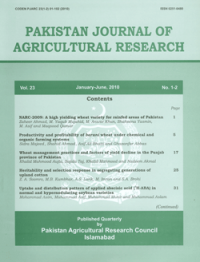Abid Hussain*, Imdad Hussain Mirza and Muhammad Azeem Khan**
ABSTRACT
Goats have helped people to survive and thrive for countless generations. Proper feeding and management is of fundamental importance to the success of any goats’ enterprise. In Pothowar region of Punjab, household and sedentary system of goat production is practiced. The availability of feed varies according to the season. Goats in the region are under nourished and producing less than potential. This study was conducted to find out the feed supplementation practices of goats in the Pothowar region. Data for this study was collected for the complete calendar year 2008. Data sheets were prepared in Urdu and provided to 100 literate female household members belonging to ten villages of tehsil Talagang of Chakwal district for data collection. According to the findings of the study, average number of goats per household was four; two does and two nonmilking goats. Goats were mainly supplemented with ber (Zizyphus) leaves, wheat and mustard fodders in winter season and ber leaves, sorghum and bajra fodders in summer. Groundnut and wheat straws were main dry fodder. Wheat grains, oil seed cakes, wheat bran (choker), grams and left over dry breads were the concentrates fed to goats. On the whole about 30% metabolizable energy requirements of non-milking goats and 34% of does were fulfilled by supplementation. Goats were supplemented maximum during January-March, June, November and December and grazed for greater periods in summer and autumn than in winter and spring seasons. It can therefore be concluded that in general the months when minimum supplements were given are the better ones in terms of feed availability because majority of feed intake comes from grazing. Moreover, supplementation of goats can be improved by educating local communities about the proper supplementation and by planting palatable shrubs and fodder trees.
To share on other social networks, click on any share button. What are these?






